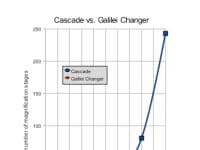The invention is meant to replace the optical zoom.
PROBLEM:
Optical zoom is an expensive, heavy and complicated device with over 100 parts. Some other drawbacks are: long development times, very complex optical calculations, the large number of the lenses and it can't be miniaturized. Compared to the high costs, the optical quality is rather poor, especially for big magnification ranges. Also for the zoom with variable lenses and the “digital” zoom the quality decreases dramatically with magnification range increasing.
SOLUTION:
Combination of discrete magnification changers (MC) like e. g. Galilei MC with a zoom to fill the gap between the discrete magnification stages. To save space and resources it preferably will be zoom with variable lenses or “digital” zoom. Discrete MCs have excellent quality. They can have extreme big magnification ranges at the same time. And they have very simple mechanics. If more than a few magnification stages are needed MC cascades will help. Fig. 1 compares the number of magnification stages for a MC cascade and a Galilei MC for the same number of lenses. Using magnification changers without moving parts the device can be very robust.
Example: cascade of two discrete magnification changers with 4 lenses and 9 magnification stages with equal distances of factor 1.3 provides a zoom range of >10 with excellent optical quality for zoom with variable lenses and good optical quality for “digital” zoom. With both zooms the magnification range is even larger. Without any of theses zooms the magnification range is already >8. Fig. 2 shows the 9 magnification stages, the line indicating continuous zoom should be prolonged to the right for the “digital” zoom by the distance between the stages or by half that amount to the left and to the right for the zoom with variable lenses. The lenses can be compositions of lenses and others optical components (e. g. gratings, DOEs) for optical corrections.
CONCLUSION:
Two technologies combined at their best: excellent optics and simple mechanics of a MC (cascade) and small zoom with variable lenses or “digital” zoom make an optical hit.
TECHNOLOGY BENEFITS:
- Big magnification range
- Big number of magnification steps
- Miniaturizability
- High optical quality
- Low development and product costs
- Short time to market
- Simple optics / simple mechanics
- Reproducibility
APPLICATIONS:
- Mobile Phone Camera (>300Million pcs/a sold worldwide)
- (Video)Camera / Webcam (>100Million pcs/a)
- Microscope
- Head Loupe
- Bioscanner
- Copier
- Surveillance Camera
- (Video)Projector
Like this entry?
-
About the Entrant
- Name:Andreas Obrebski
- Type of entry:individual
- Patent status:patented





